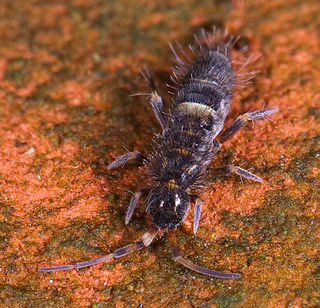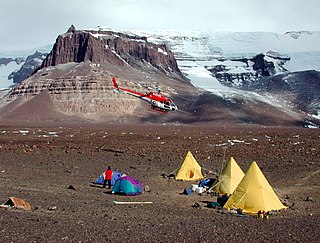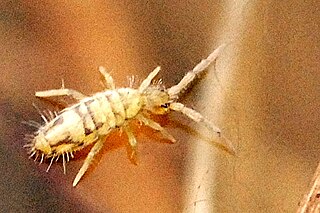
The Ross seal is a true seal with a range confined entirely to the pack ice of Antarctica. It is the only species of the genus Ommatophoca. First described during the Ross expedition in 1841, it is the smallest, least abundant and least well known of the Antarctic pinnipeds. Its distinctive features include disproportionately large eyes, whence its scientific name, and complex, trilling and siren-like vocalizations. Ross seals are brachycephalic, as they have a short broad muzzle and have shorter fur than any other seal.

The order Symphypleona is one of the three main groups of springtails (Collembola), tiny hexapods related to insects. When the springtails were still believed to be an order of insects, the Symphypleona were ranked as a suborder.

Springtails (Collembola) form the largest of the three lineages of modern hexapods that are no longer considered insects. Although the three orders are sometimes grouped together in a class called Entognatha because they have internal mouthparts, they do not appear to be any more closely related to one another than they are to all insects, which have external mouthparts.
Cryptopygus antarcticus, the Antarctic springtail, is a species of springtail native to Antarctica and Australia. Cryptopygus antarcticus average 1–2 millimetres (0.04–0.08 in) long and weigh only a few micrograms. Like other springtails, the Antarctic springtail has been found to be useful as a bioindicator of pollution and has been used to study microplastic pollution in Antarctica. They also tend aggregate, by signaling to other individuals via pheromones, especially when temperatures are low, to avoid a high water loss rate.

Beacon Valley is an ice-free valley between Pyramid Mountain and Beacon Heights, in the Quartermain Mountains of Victoria Land, Antarctica. It was mapped by the British Antarctic Expedition, 1910–13, and named by the Victoria University of Wellington Antarctic Expedition (VUWAE) (1958–59) after Beacon Heights.
Antarctic fish is a common name for a variety of fish that inhabit the Southern Ocean. There are relatively few families in this region, the most species-rich being the Liparidae (snailfishes), followed by Nototheniidae. The latter is one of eight different families that belong to the suborder Notothenioidei of the order Perciformes. They are also called notothenioids, but this name is also used to describe the other three, non-Antarctic families and some of the non-Antarctic genera in the mainly Antarctic families belonging to the suborder.

Cryptopygus is a genus of springtails. Cryptopygus belongs to the Isotomidae family.
Cryptopygus agreni is a species of springtail in the genus Cryptopygus. It is sometime considered a synonym for Hemisotoma pontica

Parisotoma notabilis is a species of elongate-bodied springtail in the family Isotomidae. It can be found in both Europe and North America, with four distinct lineages differing significantly in both mitochondrial and nuclear genetics. The species reproduces by parthenogenesis.

Isotomurus is a genus of elongate-bodied springtails in the family Isotomidae. There are at least 40 described species in Isotomurus.

Entomobrya nivalis, the cosmopolitan springtail, is a species of slender springtails in the family Entomobryidae.
Mount Rittmann is a volcano in Antarctica. Discovered in 1988–1989 by an Italian expedition, it was named after the volcanologist Alfred Rittmann (1893–1980). It features a 2 kilometres (1.2 mi) or 8 by 5 kilometres wide caldera which crops out from underneath the Aviator Glacier. The volcano was active during the Pliocene and into the Holocene, including large explosive eruptions; a major eruption occurred in 1254 CE and deposited tephra over much of Antarctica. Currently, the volcano is classified as dormant.

Lake Washburn is a lake that formerly existed in the Taylor Valley, McMurdo Dry Valleys, Antarctica. It formed when climatic changes and an expansion of ice caused the flooding of the valley, between 23,000 and 8,340 radiocarbon years ago. Its extent and elevation are unclear but Lake Bonney and Lake Fryxell are considered to be its present-day remnant.

Keith Arthur John Wise, often referred to as K. A. J. Wise, was a New Zealand entomologist. Originally employed at the Department of Scientific and Industrial Research, Wise began working with the Bishop Museum in the early 1960s, coordinating field programmes for United States visits to Antarctica and Subantarctic islands. This work led Wise to identify and describe large numbers of novel species, including many species of springtail. In 1965, Wise became the first Curator of Entomology at the Auckland War Memorial Museum, where he was integral in creating the first entomology section within the natural history gallery.

Acanthomurus rivalis is a species of springtail belonging to the family Isotomidae. The species was first described by Keith Arthur John Wise in 1964. The species is native to Campbell Island in the New Zealand Subantarctic Islands.

Cryptopygus campbellensis is a species of springtail belonging to the family Isotomidae. The species was first described by Keith Arthur John Wise in 1964. The species is native to Campbell Island in the New Zealand Subantarctic Islands.
Cryptopygus cisantarcticus is a species of springtail belonging to the family Isotomidae. The species was first described by Keith Arthur John Wise in 1967. The species is native to the Cape Hallett area of Northern Victoria Land in East Antarctica and the surrounding offshore islands, including the Balleny Islands.
Tullbergia mediantarctica is a species of springtail belonging to the family Tullbergiidae. The species was first described by Keith Arthur John Wise in 1967, and is only known to occur around the Shackleton Glacier area of Antarctica.
Pseudosorensia is a genus of springtails belonging to the family Isotomidae. The genus was first recognised by Dora Esther Cutini de Izarra in 1972.
Pseudosorensia atlantica is a species of springtail belonging to the family Isotomidae. The species was first described by Keith Arthur John Wise in 1970, and is found in South Georgia.









